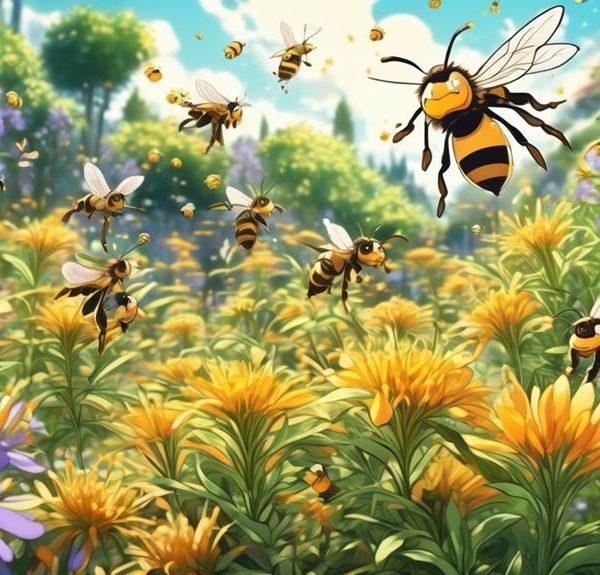Peek into the captivating world of bees and their relationship with the summer-blooming phlox in your garden.

Do Bees Like Phlox?
You might not be aware, but the bee's attraction to flowers isn't random; it's a fascinating interplay of color, scent, and nectar availability.
Phlox, a vibrant and fragrant flower that blooms prolifically throughout summer, is one such flower that seems to pique the interest of bees.
But does this mean bees actually like phlox? Well, that's a question with an answer that's more complex than it seems.
Stick around, and you'll uncover the intriguing relationship between these buzzing pollinators and your garden's phlox.
Key Takeaways
- Phlox flowers have several attractive features for bees, including tubular structures that provide easy access to nectar, abundant pollen production, and a fragrant scent that serves as a beacon.
- Bees play a crucial role in pollination, which is essential for plant reproduction and biodiversity.
- Phlox flowers are specifically attractive to bees due to their vibrant colors, comfortable landing pads, sweet fragrance, high nectar production, and extended blooming period.
- Bees are naturally drawn to phlox flowers because of their bright colors, pleasant scent, ample nectar, easy access to nectar and pollen, and the alignment of their sensory perceptions and survival needs with phlox characteristics.
Understanding the Phlox Plant
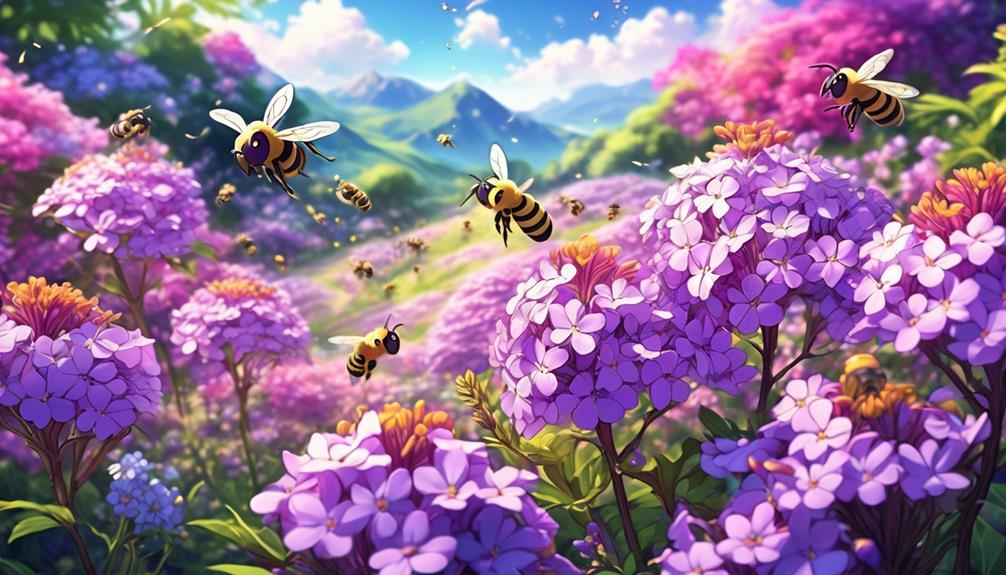
To fully grasp why bees might be attracted to phlox, you need to first understand the intricate details of the phlox plant itself. Phlox is a genus of 67 species of perennial and annual plants hailing from North America. It's a plant that's hardy and versatile, thriving in diverse conditions.
At the heart of its appeal to bees is its flower structure. The phlox flower, typically vibrant in pink, purple, or white hues, boasts five petals fused at the base, forming a tube. This tubular structure is ideally suited for bees' feeding habits, as it provides a direct pathway to the nectar. Each flower also contains a single pistil and five stamens, enhancing its pollen-producing capabilities.
Crucially, phlox blooms in late spring and early summer, providing a reliable food source when bees are most active. Moreover, its fragrance, particularly strong at night, serves as an olfactory beacon for bees.
Therefore, in a nutshell, it's not just the visual appeal of phlox that entices bees. It's the sum of these characteristics – tubular flowers, abundant pollen, seasonal timing, and enticing fragrance – that makes phlox a magnet for bees.
Importance of Bees in Pollination
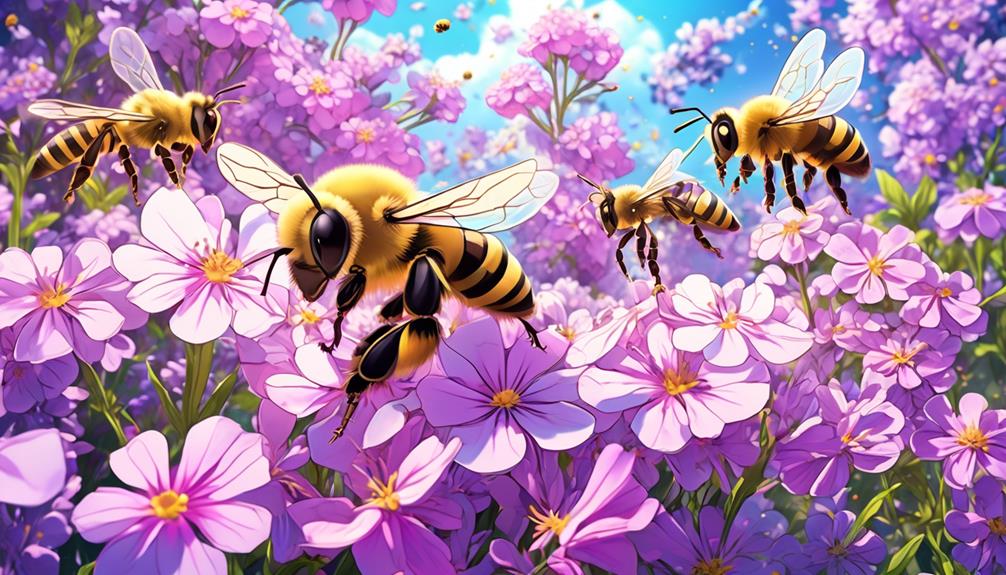
While phlox's unique allure for bees has been established, you might still be wondering why this interaction holds such ecological significance; this brings us to the indispensable role that bees play in pollination.
As bees flit from flower to flower, they're not just collecting nectar. They're also unintentionally collecting and depositing pollen, which is crucial for plant reproduction. Without bees' meticulous work, many plants wouldn't be able to reproduce effectively, leading to a significant drop in biodiversity.
Here's a quick snapshot of the pollination process:
Action | Result |
|---|---|
Bee lands on flower | Pollen sticks to bee's body |
Bee moves to new flower | Pollen rubs off on new flower's stigma |
Pollen travels down stigma | Fertilizes the ovule, forming a seed |
Seed matures | Develops into fruit |
Fruit disperses seeds | New plants grow |
This process is more than just an interesting quirk of nature – it's an essential part of our ecosystem. So, when you see bees buzzing around your phlox, they're not just enjoying a sweet treat. They're also playing a critical role in maintaining the biodiversity of your garden and the world at large.
Bees' Attraction to Phlox Flowers
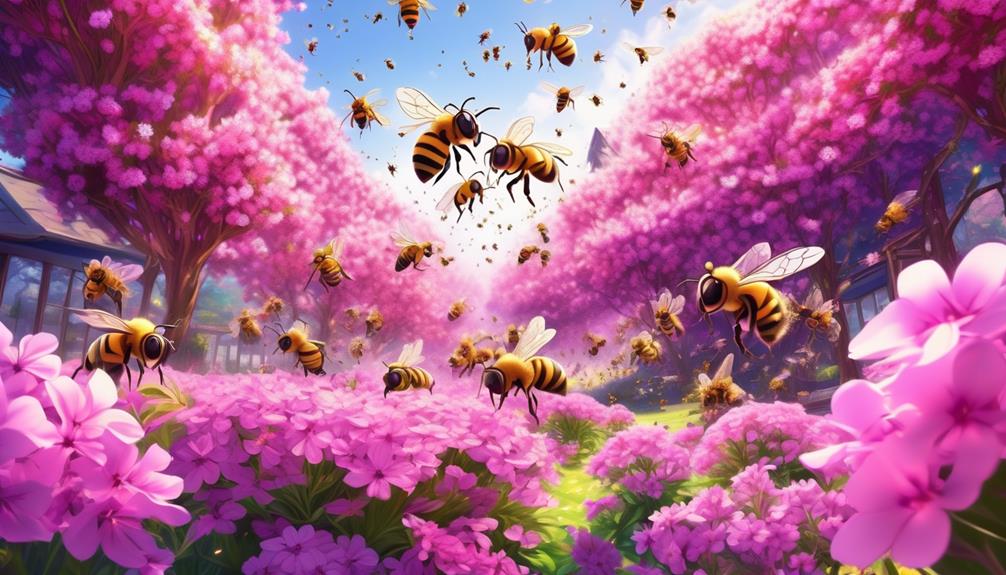
Often, you'll notice bees gravitating towards your phlox flowers, a phenomenon driven by the plant's specific characteristics that are particularly appealing to these pollinators. Let's delve deeper into what makes these flowers an enticing destination for bees.
Phlox flowers, with their vibrant colours, draw in bees from a distance. Bees perceive colours differently, and phlox's purples and pinks stand out in their vision. Moreover, the flower's shape makes it a comfortable landing pad for bees. The flat, open blossoms allow easy access to the nectar and pollen that bees seek.
Phlox's scent is another magnet for bees. They emit a sweet fragrance that's highly attractive to bees, guiding them to the nectar source. The high nectar production of phlox flowers, rich in sugar, is a reliable energy source for bees.
Additionally, phlox flowers bloom for an extended period, providing a continuous food supply for bees in the summer. This makes your garden a hotspot for these pollinators, aiding in their survival and in turn, pollination.
In essence, your phlox plants aren't just beautifying your space; they're also contributing to the vital process of pollination by attracting and feeding bees.
Contributing Factors for Bees' Preference

Several elements contribute to the preferential behavior of bees towards phlox flowers, primarily revolving around their sensory perception and biological needs. Lured by bright colors and sweet nectar, bees are naturally drawn to these vibrant flowers.
Consider the following factors and their roles:
Factor | Role |
|---|---|
Color | Bees can see ultraviolet light and are attracted to bright colors, particularly blue and violet hues, which phlox flowers exhibit. |
Scent | Phlox emits a pleasant fragrance that bees find irresistible, guiding them to the nectar source. |
Nectar | Phlox produces ample nectar, a rich source of energy for bees. |
Shape | The shape of phlox flowers allows easy access to nectar and pollen, encouraging bee visits. |
Consequently, bees' sensory perceptions and survival needs align perfectly with the characteristics of phlox flowers. Because of the floral traits of color, scent, nectar supply, and shape, bees are more likely to frequent phlox, contributing to their preference. Therefore, if you're aiming to attract bees to your garden, phlox can be a beneficial addition due to these factors.
Enhancing Bee Attraction With Phlox
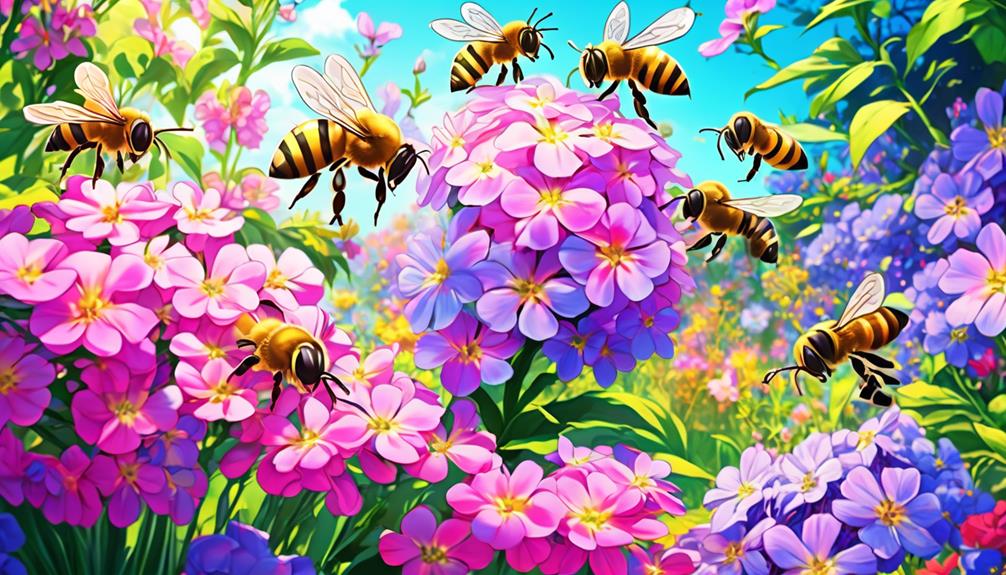
Building on the understanding of bees' attraction to phlox, you can enhance your garden's allure for these pollinators by incorporating specific varieties of phlox and implementing strategic planting practices.
The selection of phlox species plays a crucial role in enticing bees. For instance, Phlox paniculata, or garden phlox, with its large, fragrant clusters of flowers, is particularly appealing to bees. Similarly, Phlox subulata, also known as creeping phlox, works wonders in attracting bees due to its dense floral coverage.
Timing your planting to coincide with the active periods of bees is also effective. Plant phlox in early spring, as they bloom from late spring to early summer, a period when bees are most active.
Consider the arrangement of your phlox plants as well. Bees are more likely to visit large patches of the same flower, so plant your phlox in clusters rather than scattering them.
Lastly, limit your use of pesticides. These can deter bees or even prove lethal. If necessary, opt for organic or bee-friendly alternatives.
Frequently Asked Questions
What Other Flowers, Besides Phlox, Are Particularly Attractive to Bees?
You're wondering about other flowers, apart from phlox, that bees find irresistible. Well, bees can't resist lavender, coneflowers, and sunflowers. They're also fans of bee balm and black-eyed Susans.
These blooms offer rich nectar or pollen, essential for bees' survival. You'll notice, if you plant these, bees buzzing happily in your garden, aiding in cross-pollination.
Can Bees Help in the Propagation of Phlox Plants?
Absolutely, bees can greatly assist in the propagation of phlox plants. As they move from flower to flower, they collect and spread pollen, which triggers the fertilization process. This cross-pollination is essential for the production of seeds.
Are There Specific Species of Bees That Are More Attracted to Phlox Than Others?
Yes, specific species of bees are more attracted to phlox. Honey bees and bumble bees frequent phlox plants more than other species. They're drawn to phlox's brightly colored flowers and abundant nectar.
However, it's not just these bees that are attracted, but a range of pollinators including butterflies and moths. So, you're not just attracting bees when you plant phlox, you're creating a haven for a variety of beneficial insects.
Are There Any Potential Risks or Hazards for Bees When They Pollinate Phlox Flowers?
Considering potential risks or hazards for bees during pollination, there's no specific danger associated with phlox flowers.
Generally, pesticides and loss of natural habitat pose greater risks. However, if you're using specific plant treatments, it's important to check they're bee-friendly.
Can Phlox Plants Survive Without Bee Pollination?
Yes, phlox plants can survive without bee pollination. They're self-fertile, meaning they can pollinate themselves without the aid of bees. However, bee pollination significantly boosts their seed production, enhancing their propagation.
While they'd still flourish in a bee-less environment, their spread wouldn't be as vigorous. It's a delicate balance in nature—you scratch my back, I'll scratch yours. Bees need phlox for nectar, and phlox need bees for efficient pollination.
Conclusion
Indeed, bees do love phlox. These vibrant, nectar-rich flowers are a bee's delight, playing a crucial role in their pollination activities.
It's the combination of the phlox's color, fragrance and nectar availability that draws bees in. By understanding this, you can help enhance your garden's bee attraction.
So, don't just plant phlox for their beauty, do it for the bees too! After all, a garden buzzing with life is a truly beautiful sight.


